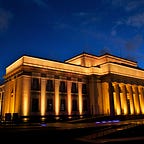Why I volunteer at Auckland Museum: Janet Anderson
Originally published at www.aucklandmuseum.com.
Janet Anderson is one of Pou Maumahara’s dedicated volunteers who comes in week after week to share her time, knowledge and insights with our visitors. When asked “Why do you do it?” Janet came up with this response.
Why do I do it?
It all started in the late 1940s when Britain was beginning to re-build after six years of conflict. My father was a great believer in knowing who you were, where you came from and knowing your city. As a consequence, he took me on route marches around London, its parks and squares, museums and landmarks until the layout was firmly embedded and there was small chance of ever getting lost.
These intrepid journeys were all started by train via Waterloo or Charing Cross stations and it was at those places that my confidence was challenged.
In the courtyard outside of the stations there were small gatherings of old men. Some had limbs missing and they looked decidedly down on their luck. Some sold matches and others sold shoelaces although they did not appear to do much trade. They had trays suspended on webbing that carried the items for sale and were worn around their necks. Some wore tattered medal ribbons pinned on overcoats and others smelled of alcohol.
They frightened me.
I did not understand why they were the way they were and my Father’s attitude to them worried me even more.
He would always talk to them, ask them questions as though he had known them all his life. Where did they serve, which regiment etc. They were polite and called my Father “Sir”. This he did not allow. “No, just an NCO, no Commission for me, same as you.”
Finally he would give them each some money for a cup of tea and a bun from the station cafeteria, shake them by the hand and say “thank you”. He did not have a great deal of spare funds — it was something he had to do.
One day I asked my Father why this chat to the men was so important. He explained that these “old boys” were soldiers of World War 1 that few people cared about anymore. They lived on meagre pensions and most had lost track of families and had no close relatives. They had each other, mates, as they had in the trenches, and it was important to them to see each other daily and despite their situation my Father pointed out that they were always clean-shaven, had neat haircuts and their worn out shoes were polished.
“They are real soldiers — the country has forgotten them but we must not.”
For some years after, Dad shared the experiences of his father (a regular soldier in the Guards Division) and his own story of World War II with me.
The decision to come to New Zealand was well made, both Grandfather and Father having served with New Zealand forces from the South African War (1899–1092) to World War II (1939–1942). They were all good men according to Dad and from a country that valued its soldiers. How right he was.
I can’t ignore the service of those whose names are on our walls or the survivors who returned and have since passed away, neither can I deny the descendants of these men who seek the details of their military history.
Maybe I was vaccinated with a bayonet — who knows, but that’s why I do it.
